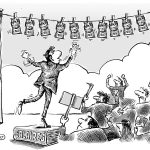« Soylent green »
Is the enthusiasm for ESG funds exaggerated?
The movie was scary, offering the vision of an overcrowded world, lost in violent cities and faced with a mysterious enterprise “Soylent Green” producing this food that no one knows what it is made of. My generation was stunned by this vision. Today’s finance is involved in fighting climate change. But hell is paved with good intentions, it’s well known. This time, the risk and consequences are significant. The almost simultaneous publication of two recent reports raises attention to the risks of a runaway financial sphere for so-called socially responsible investment and in particular decarbonisation funds. Speculative bubble and “greenwashing” are the evils that would threaten this asset class, at the risk of even calling into question the most salutary investment efforts.
In its September issue, the Bank for International Settlements1 is concerned about the inflow of capital to ESG funds, and the surge in this asset class, which could well be uncorrelated not only from the performance of the companies that compose it, but also from the stated objectives. In short, in view of the masses at stake, the BIS sees the risk of the formation of a new Internet bubble. It notes that investors’ interest is focused on bonds that focus on the climate transition. The report estimates that outstanding ESG funds have reached nearly $35 trillion in 2020 – or nearly 36% of all investment funds under management worldwide. Investors are nevertheless involved to varying degrees: ETFs, mutual funds, US pension funds have experienced the most remarkable growth in the last five years, while hedge funds are said to be lagging behind in the composition of their portfolios. However, the BIS believes that companies in the renewable energy sector are experiencing higher valuations than growth stocks – already considered very expensive too. The acceleration of the market is reminiscent of that of the MBS2 before 2008, or even of the American railways in the second half of the nineteenth century, of very sad and disturbing memory. No doubt for the International Bank, therefore, the overheating threat, stoked by the hunt for yields, while the monitoring of portfolios, as well as the absence of sufficiently standardized and reliable criteria and definitions, leave too much room for speculation and false promises.
More and more funds are adopting – and grouping together – around defined and verified common criteria.
This is the point of view taken up by the researchers at EDHEC Business School and authors of the report entitled: “Doing good or feeling good3“, who are concerned about the lack of transparency and method in the analysis of climate investments, at the risk of deceiving savers and undermining the effort actually made in this area. According to the authors of the study, the real impact of climate considerations on portfolio allocations remains limited to only 12% of all investments, while the – classic – criteria – taking into account the market capitalization of assets – still largely dominate allocation decisions (88%). If, in addition, investors introduce social and governance considerations, the climate score would fall to a meagre and insufficient 6% of portfolios! The authors then list the reasons for these “failures”. For example, we find the “ways and means” to “green” a portfolio that would consist in underweight important sectors that are in fact central to the climate transition (such as electricity). And to denounce other artifices that – even worse – lead to increase the weight of companies that actually contribute to the deterioration of the climate. A crowning achievement! Authors’ conclusion: with less than 50% effective representation of climate criteria, a green portfolio is not green.
All is not lost, readable and reliable standards and taxonomies have indeed appeared. More and more funds are adopting – and grouping together – around defined and verified common criteria (such as those related to the Paris Agreements). Their growing weight in the world of green impact investing should be a drive-up.
Investor awareness is a reality that should not be overlooked. Yes, “the climate is worth more than 12%.”
1 BIS Quarterly Report, 20 September 2021
2 MBS, Mortgage Back Securities
3 EDHEC – scientific Beta «Advanced ESG and Climate Investing «Doing Good or Feeling Good?” Detecting Greenwashing in Climate Investing August 2021
Valérie Plagnol – Sep2021 – Published in French in www.allnews.ch – Cartoon ©Barret



